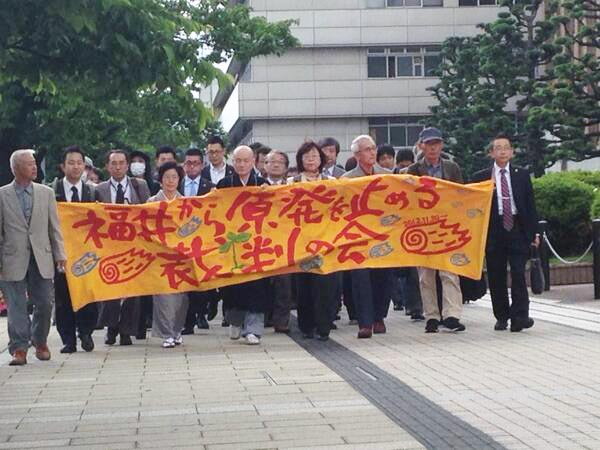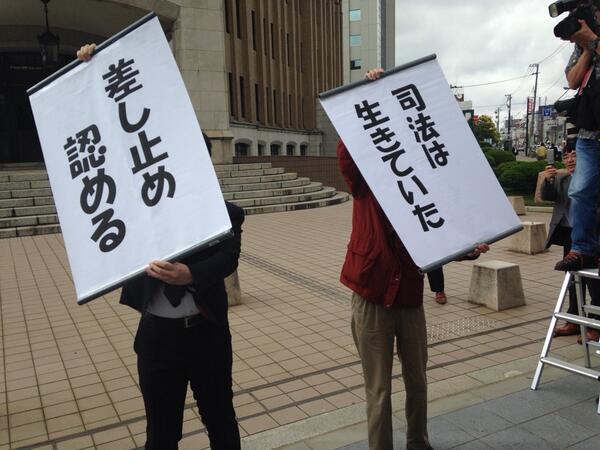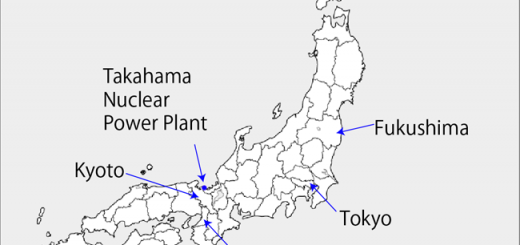Court ruling bans restart of Ohi Nuclear Power Plant Nuke Info Tokyo No. 160
 |
| Plaintiff’s group heading toward Fukui District Court |
On May 21, 2014, the Fukui District Court handed down a verdict recognizing outright the plea of residents living within 250 km of the Kansai Electric Power Company’s (KEPCO) Ohi Nuclear Power Plant to ban the restart of the plant’s Units 3 and 4 (PWR, both 1,180 MW), stating that “the nuclear power plant must not be operated.” This is the first court decision in the more than 20 lawsuits calling for injunctions against NPP construction or restarts that have been newly brought since the Fukushima Daiichi Nuclear Power Station accident occurred. The reason why the verdict in this trial has been handed down before those in trails that were already in progress at the time of the Fukushima nuclear accident is that the plaintiffs, the residents, narrowed down the number of points of contention in order to expedite the court’s ruling. It can be said that the result is a revolutionary verdict that fundamentally alters previous legal judgments.
The verdict points out the effect on personal rights by stating that if a nuclear accident were to occur there would be a “possibility of bringing about a situation where people are deprived of fundamental rights over an extremely extensive area” and that “economic activities that entail, even hypothetically, such a danger, while considering that the existence itself of those activities is impermissible under the Constitution may be an extreme argument, even if there is at least the slightest concrete risk of bringing about such a situation, it is natural that its prohibition be recognized.”
Having said that, the ruling stated that “the nuclear power plant in question has the following defects in the cooling function and containment structure at the time of an earthquake” and carefully enumerated the specific risks. The verdict also made it clear that although new reference seismic movements had been established for the so-called test of compliance with the new safety standards now being carried out by the Nuclear Regulation Authority (NRA), and it has been concluded that NPPs can withstand earthquakes that are likely to occur, this was considered to be unsound. This signifies that the court believes there are insufficiencies in the reference seismic motions formulated by each of the power companies.
 |
| Lawyers hold signs reading ‘justice is alive’ and ‘a suspension has been ordered’ at the Fukui District Court |
In response to the claim of the defendant, KEPCO, that the suspension of operations of NPPs resulted in “an outflow and loss of national wealth,” the verdict stated that “even if the suspension of operation of the NPP in question resulted in a large trade deficit, this should not be termed an outflow or loss of national power, since an abundant national territory and the citizens who put down roots and live their daily lives there are the national wealth, and this court believes that the inability to reclaim this is what we should term a loss of national wealth.”
These grounds for the decision are not limited to risks relevant to Ohi Units 3 and 4 alone, but are true of all NPPs. There is a strong possibility that this verdict will be repeated in restart prohibitions in the trials that are now ongoing throughout the country. On May 22, KEPCO appealed the ruling at the Kanazawa Branch of the Nagoya High Court. In the past, verdicts blocking NPP operations have twice been overturned by rulings of higher courts, but if a series of verdicts banning NPP restarts is handed down, it will likely become much harder for higher courts to overrule them.
Baku Nishio (Co-director of CNIC)

